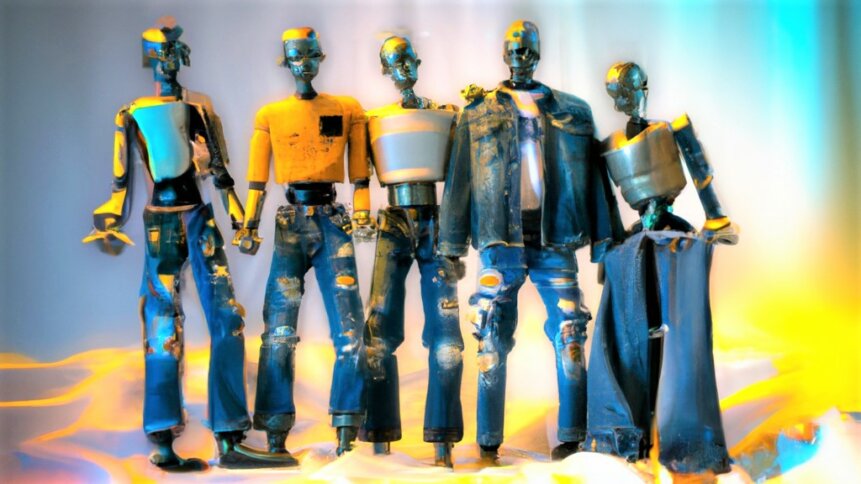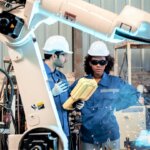Will AI take our jobs? Yes and…

|
Getting your Trinity Audio player ready...
|
Robots have been elbowing employees out of manufacturing jobs for years. And now there’s another automation trend in town – generative AI. Large language models (LLMs) have transformed chatbots from rule-based customer agents into powerful knowledge tools, such as ChatGPT, which are capable of reshaping operations across a wide range of industries. At the same time, text-to-image creation enabled using Stability AI’s Stable Diffusion or OpenAI’s DALL-E2 – to give just a couple of examples of generative AI tools capable of producing jaw-dropping photos and artwork from a sequence of text prompts – open design studio doors to anyone. And these developments beg the question, will generative AI take our jobs?
It only takes a few minutes of using ChatGPT to realize that there’s now a different way of discovering information online. And finding answers by scrolling through pages of search engine results feels pedestrian in comparison. Google isn’t about to roll over and surrender its customer base to OpenAI, but the rapid success of advanced chatbots has wobbled tech giants who’ve found themselves to be on the back foot. And OpenAI isn’t just making waves in internet search, API access allows developers to integrate advanced chatbot and imaging capabilities into all kinds of software, and these products will radically change the workplace.
Automation is hard to ignore
Lawyers, contract negotiators, contact center workers, photographers, designers, content makers, authors, and even models – the list of professions impacted by generative AI is a long one. But there’s another side to the question of whether AI will take our jobs. Automation is hard for companies to ignore. The benefits of integrated LLMs, which can be fine-tuned on enterprise data to make their output even more relevant to organizations, can be huge. For example, Logikcull is applying GPT-4 functionality to electronic discovery (eDiscovery) – the practice of collecting, processing, reviewing, and producing information in response to a legal request or requirement. And the firm claims that the integration of AI-enabled and other automation features could reduce the workload that goes into discovery activities by 90%.
Platforms can ingest a variety of enterprise data – including spreadsheets, documents, emails, and instant messages – and combine all of the information channels into a single, searchable resource. Users can rapidly query millions of Slack and Teams messages, for example, and apply a variety of search filters, including sorting by reaction emojis, to navigate to conversations of interest. And when it comes to redaction, sensitive details can be removed globally across all channels. There are plenty of time-saving opportunities up for grabs, and eDiscovery tools have many other features worth noting, including the capacity to summarize documents and spreadsheets.
Algorithms and deep learning models that can take the drudgery out of routine tasks are hard to object to. Providers are busy developing speech-to-text systems that can make sense of meetings – auto-generating minutes, and reminding attendees of key action points. Sometimes AI solutions become a necessity. For example, Summize – a UK firm that provides a range of contract lifecycle management (CLM) solutions powered by generative AI – was founded to address the backlog of requests made to organizations’ legal front door teams.
Businesses have much more to explore when it comes to using generative AI. GPT-4 – the latest version of OpenAI’s LLM, which can recognize images as well as text – is capable of recommending recipes based on a photograph of the inside of your fridge or food cupboard. It’ll also generate a shopping list for you and provide step-by-step details on food preparation. And it’s not a stretch to imagine how these features could extend into industrial settings – warehouse management, maintenance and troubleshooting of equipment, and the interpretation of insurance details are just a few possibilities.
Earlier this year, ProovStation announced that it had raised EURO 10.4 million to roll out a time-saving network of AI-assisted testing stations for the sale of used cars. Digital cameras capture a 360-degree view of the vehicle and, combined with magnetic tire sensors, can generate accurate inspection data in seconds – many times faster than human experts. Automation has long been a theme in the car industry, and the tension between employment and technological progress continues. For example, the production of electric vehicles (EVs) still needs human workers, but fewer than for models fitted with an internal combustion engine.
Biases and stereotypes
The application of AI is a thought-provoking topic, and surfaces a range of issues beyond whether machines are taking our jobs. Writing in MIT Technology Review, Melissa Heikkilä, reminds readers of the tendency of AI to amplify harmful biases and stereotypes. And her commentary points out that as generative AI tools are rolled out in a greater number of products, the danger of harmful biases being reinforced increases. Hugginface, which helps users share machine learning models and data sets, has built tools to quantify social biases in image generation algorithms. Its Diffusion Bias Explorer web app can compare different models and the images that they generate for a given profession. And the output highlights that there’s progress to be made, but there are brighter points too.
For example, Levi Strauss has teamed up with Lalaland.ai – a digital fashion studio in the Netherlands, which uses generative AI to enable clothing brands to show 3D designs on lifelike digital models. The partnership, which was announced this month, could accelerate the number and diversity of models that feature in apps and online catalogs and gives shoppers the means to customize their experience as they browse for products. Levi Strauss explains that it is planning tests of the technology to supplement its use of human models. “We know our customers want to shop with models who look like them, and we believe our models should reflect our consumers, which is why we’re continuing to diversify our human models in terms of size and body type, age and skin color,” said the firm.
Levi Strauss has a strong track record in using technology to improve its business operations. For example, the denim company was an early adopter of digital twins to manage the whereabouts of its jeans and other clothing products in-store. As mentioned, the advantages of automation are too strong for firms to ignore, especially when systems are highly scalable.
Generative AI has mastered text, speech, and images, with text-to-video rumored as being next on the list. So this won’t be the last we’ll hear on the topic of will AI take our jobs.











